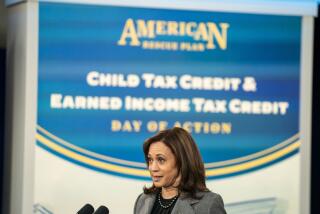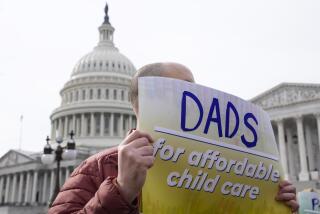House Leaders Seek to Avoid Fight on Child Care
- Share via
WASHINGTON — House leaders are working toward a compromise child-care bill that would preserve a major new program supported by the Democrats while incorporating new tax breaks that were approved by the Ways and Means Committee on Thursday and go beyond what President Bush has been seeking.
The aim is to prevent a potentially bruising House floor fight over competing child-care proposals. But negotiations on the legislation were at a standstill Friday, and it remained unclear when the measure would reach the House floor for a vote.
“The President has much of what he wants, the Democrats have much of what they want; everyone has something,” said Marian Wright Edelman, president of the Children’s Defense Fund, a children’s advocacy organization. “So why are they mucking around?”
The bill as approved by the House Education and Labor Committee would provide a total of $1.75 billion to expand Head Start services and school-based child-care programs, establish grants to local education agencies and provide grants to the states to establish a major new network of child-care services for infants, toddlers and young children.
But the new grant program was rejected by the Ways and Means Committee, which shares jurisdiction over child-care programs. In a step taken last week and affirmed Thursday, Ways and Means deleted the new program and substituted funding for child-care services under existing law, Title XX of the Social Security Act.
Title XX gives states money for a range of social services, which are not limited to child care. The committee, a spokesman said, believes that the existing program would provide a more reliable source of funds than the new one.
But child-care advocates argue that the bill, as originally written, provides for a far better child-care program than Title XX and should be maintained. The Senate already has approved a program similar to the one sought by the House Education and Labor Committee.
The Ways and Means Committee also accepted a substantial increase in the earned-income tax credit for low-income workers with children.
Under existing law, workers with children qualify for a credit of 14% of their first $6,500 of earned income, for a maximum credit of $910. The credit is phased out as incomes rise, and those who earn $10,240 or more get no credit. Workers whose credit exceeds the taxes they owe get the difference back from the government in the form of a check.
The Ways and Means formula would increase the size of the credit, expand the income eligibility ceiling and adjust the credit according to family size.
Starting in 1991, the credit would be 17% of the first $7,160 of income for workers with one child, 21% for two children and 25% for three or more children. The maximum credit would be $1,790, and taxpayers who earned up to $21,000 a year would qualify for a partial credit.
In addition, there would be a supplemental credit of up to $430 for low-income workers with children under the age of 6.
Bush had proposed a tax credit of up to $1,000 a year per child under age 4. Critics of the Bush plan argued that the maximum credit--approximately $20 a week for families with one young child--would not go very far toward meeting typical child-care costs. They welcomed the idea of a tax credit but said that it wasn’t enough.
Bush opposes the creation of an expanded child-care system, believing that tax credits are the appropriate solution. It is uncertain whether he would sign a measure that incorporates both elements.
More to Read
Get the L.A. Times Politics newsletter
Deeply reported insights into legislation, politics and policy from Sacramento, Washington and beyond. In your inbox three times per week.
You may occasionally receive promotional content from the Los Angeles Times.










